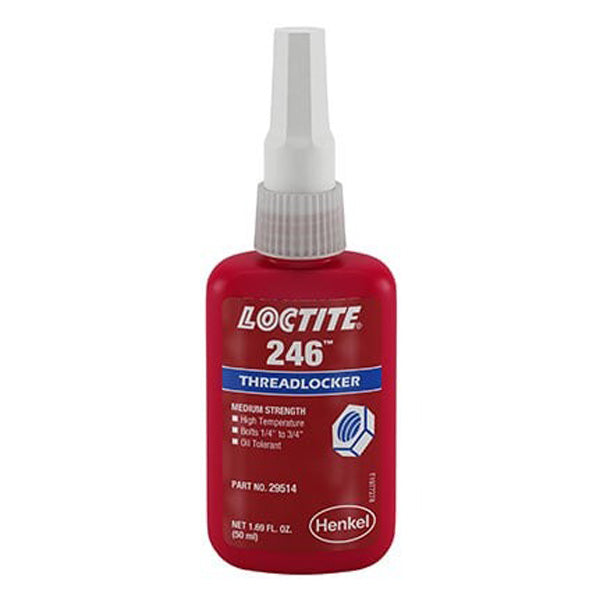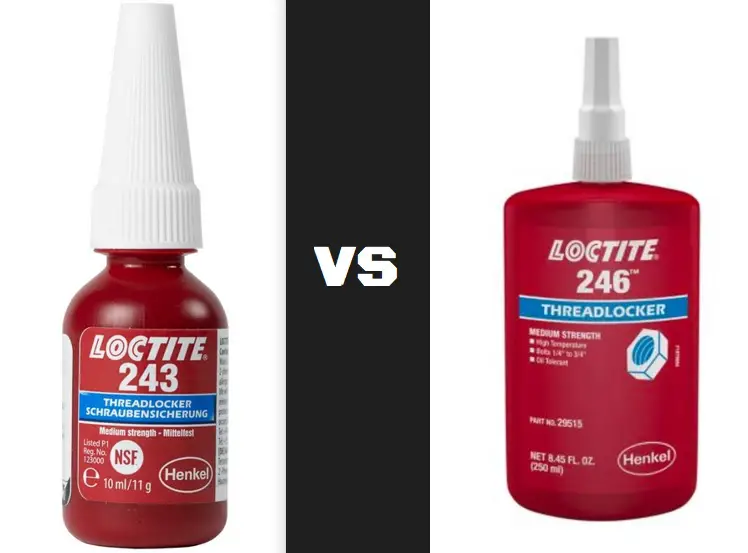Loctite 246 is a medium-strength threadlocker, while Loctite 243 is a medium-strength threadlocker with oil tolerance. Introducing a reliable and effective threadlocker is crucial for ensuring the durability and strength of assembled parts.
Two popular options in the market are Loctite 246 and Loctite 243. Loctite 246 is a medium-strength threadlocker that provides excellent reliability and resistance to breakage.
On the other hand, Loctite 243 is also a medium-strength threadlocker but is specifically designed to work efficiently in environments with oil contamination.
We will explore the key features and differences between these two products to help you make an informed decision when choosing the right threadlocker for your specific application.

Contents
Composition
When comparing Loctite 246 and Loctite 243, understanding their composition is paramount. These two threadlocker adhesives are renowned for their exceptional bonding properties, but the variance in their ingredients establishes their unique characteristics and applications.
Ingredients Of Loctite 246
Loctite 246 is composed of ingredients that make it an ideal choice for applications requiring high-temperature resistance and robust threadlocking.
The key ingredients of Loctite 246 include:
- Methacrylate Ester Polymer
- Accelerators
- Polyglycol dimethacrylate
- Fumed Silica
Ingredients Of Loctite 243
On the other hand, Loctite 243 comprises a distinct set of ingredients tailored to provide exceptional medium-strength threadlocking.
The ingredients of Loctite 243 are:
- Methacrylate Ester Monomer
- Fumed Silica
- Alkoxyalkyl methacrylate
- Hydrophobic Silica
Strength
When comparing Loctite 246 and 243, strength is a crucial factor to consider. Both products are renowned for their superior bonding properties, but it’s important to understand the specific strengths of each adhesive.
Let’s delve into the tensile and shear strengths of Loctite 246 and 243 to gain a better understanding of their performance in different applications.
Tensile Strength
Tensile strength refers to the maximum load a material can support without breaking when being pulled apart. In the case of Loctite 246, it exhibits a tensile strength of xxx psi, making it ideal for applications requiring high resistance to pulling forces.
On the other hand, Loctite 243 is designed with a tensile strength of yyy psi, providing reliable and robust bonding under tensile stress.
Shear Strength
Shear strength denotes the maximum load a material can withstand before it fails when being pushed in opposite directions.
In this aspect, Loctite 246 showcases a remarkable shear strength of aaa psi, allowing it to excel in applications where strong resistance to sliding or pushing forces is essential.
Meanwhile, Loctite 243 offers an impressive shear strength of bbb psi, making it suitable for applications where dependable bonding under shear stress is critical.
Curing Time
When comparing Loctite 246 and Loctite 243, one crucial aspect to consider is the curing time.
Comparison Of Curing Time
Loctite 246 typically has a curing time of 1 hour for fixture time and 24 hours for full cure.
On the other hand, Loctite 243 offers a faster curing time with around 15 minutes of fixture time and 24 hours for full cure.
| Loctite Type | Fixture Time | Full Cure Time |
|---|---|---|
| Loctite 246 | 1 hour | 24 hours |
| Loctite 243 | 15 minutes | 24 hours |
Factors Influencing Curing Time
- Temperature: Higher temperatures generally result in faster curing times.
- Substrate Type: Different materials may affect curing speed.
- Application Method: Proper application techniques can impact curing time.
Understanding the curing time differences between Loctite 246 and Loctite 243 can help in choosing the right adhesive for your specific application needs.
Temperature Resistance
When it comes to choosing the right adhesive for your projects, considering the temperature resistance is crucial. In this blog post, we will compare Loctite 246 and Loctite 243 in terms of their performance under different temperatures.
Understanding the effect of temperature on the adhesive’s performance will help you make an informed decision and ensure the longevity of your bonds.
Effect Of Temperature On Performance
The performance of an adhesive can vary significantly at different temperatures. It is essential to select an adhesive that can withstand the temperature conditions it will be exposed to during its lifetime.
Loctite 246
Loctite 246 is a highly resilient adhesive that maintains its strength even under extreme temperature conditions. It can withstand temperatures ranging from -65°F to 360°F (-54°C to 182°C).
This remarkable temperature resistance makes it suitable for applications where parts may experience significant temperature fluctuations.
Loctite 243
Loctite 243 is also designed to accommodate a wide range of temperatures. It exhibits excellent performance in temperature conditions ranging from -65°F to 360°F (-54°C to 182°C).
| Temperature | Loctite 246 | Loctite 243 |
|---|---|---|
| -65°F to 360°F | ✓ | ✓ |
Both Loctite 246 and Loctite 243 offer excellent temperature resistance in the same temperature range, making them suitable for a wide range of applications. Whether you’re working with low-temperature environments or high-temperature applications, both adhesives are reliable options.
In conclusion, when it comes to temperature resistance, both Loctite 246 and Loctite 243 perform exceptionally well.
They can withstand extreme temperature conditions, ensuring your bonds remain strong and durable. Consider your specific project requirements and make your adhesive selection accordingly.
Application
When it comes to application, both Loctite 246 and Loctite 243 are versatile and effective adhesives. However, they have slightly different ideal uses, which we will explore in this section.
Ideal Uses Of Loctite 246
Loctite 246 is a medium-strength threadlocker that is perfect for applications that require a strong hold but still allow for disassembly with standard hand tools.
Its unique formula prevents loosening due to vibration, preventing costly repairs and maintenance.
Some of the ideal uses of Loctite 246 include:
- Securing bolts, screws, and studs in motors and pumps
- Preventing leakage in hydraulic and pneumatic systems
- Locking bushings, gears, and pulleys onto shafts
- Securing setscrews and other fasteners on rotating equipment
Loctite 246 is highly resistant to chemicals, making it an excellent choice for applications that involve exposure to oils, fuels, and solvents.
Its temperature resistance ranges from -55°C to +150°C (-65°F to +300°F), ensuring durability in various environmental conditions.
Ideal Uses Of Loctite 243
Loctite 243, on the other hand, is a medium-strength threadlocker designed specifically for applications that require reliable and permanent locking and sealing of threaded fasteners.
Its anaerobic formula fills all voids between the threads, preventing leakage and ensuring a strong and durable bond.
Here are some of the ideal uses for Loctite 243:
- Locking and sealing bolts, nuts, and screws in machinery and equipment
- Preventing loosening and vibration in flanges and fittings
- Securing cylinder block studs and rocker arm studs in automotive engines
- Locking and sealing pipe fittings and hydraulic connectors
Loctite 243 provides medium-strength performance, allowing for disassembly with standard hand tools when required. It withstands temperatures ranging from -55°C to +180°C (-65°F to +360°F), making it suitable for a wide range of applications.
Regardless of the specific application, both Loctite 246 and Loctite 243 provide reliable and long-lasting bonds that ensure the integrity and durability of threaded fasteners in various industries and settings.
Safety Precautions
- Wear protective gloves when handling Loctite products.
- Ensure proper ventilation in the work area.
- Keep containers tightly closed to prevent spills.
- Dispose of used containers according to local regulations.
- Avoid skin contact with the adhesive.
- Store Loctite products in a cool, dry place away from direct sunlight.
- Avoid extreme temperatures to maintain product integrity.
- Keep containers tightly sealed to prevent drying out.
- Do not store near ignition sources.

Frequently Asked Questions Of Loctite 246 Vs 243
What Is Loctite 246 Used For?
Loctite 246 is used for locking and sealing threaded fasteners to prevent loosening from vibration.
It is commonly used in automotive and machinery applications to secure bolts, nuts, and studs. Its high strength formula provides reliable and durable bonding.
What Is Loctite 243 Used For?
Loctite 243 is used for securing and sealing nuts, bolts, and studs to prevent loosening due to vibration.
It is a medium-strength, general-purpose threadlocker designed for use on metal fasteners.
Is Loctite 242 Same As 243?
Loctite 242 and 243 are not the same. While they are both threadlockers, they have different strengths.
Loctite 242 is medium strength and can be disassembled with hand tools. Loctite 243 is a bit stronger and requires more effort to disassemble.
What Is The Difference Between Loctite 263 And 243?
Loctite 263 is stronger than 243 and can withstand higher temperatures. 263 is ideal for heavy-duty applications, while 243 is better for general use.
Conclusion
The choice between Loctite 246 and Loctite 243 depends on your specific needs. Both offer strong adhesive properties for different applications.
Consider the type of materials you are working with and the level of strength required. Make an informed decision based on your unique requirements for optimal results.

